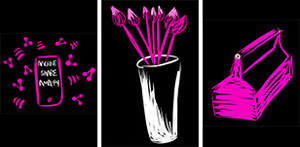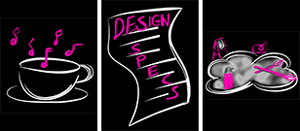Left Bank Learning: When “Work Time” Becomes “Studio Time”
Your content has been saved!
Go to My Saved Content.When you think of an artist's studio, what is the first thing that comes to mind? Large canvasses strewn haphazardly about? Globs of paint residue on every imaginable surface? Explosions of colour and organized chaos? What about the people in the studio? The artist is focused, intrinsically motivated to create -- perhaps even outwardly passionate in his process. If there are several artists sharing a space, typical in the Renaissance guilds, a certain energy is generated, and they perfect their craft by observing one another, offering constructive feedback, sometimes collaborating and other times simply working synchronously in the same physical sphere.
I have always been fascinated by the artist's process. How do they come up with ideas? How do they find time to execute them? How do their skills sharpen with experience? The more our pedagogy shifts to encourage the student as producer rather than mere consumer, the more we enable her to refine her creative competencies and, yes, consider herself an "artist" in all that she undertakes. In re-imagining the structure of my course, the shifting roles of my students and myself, and the physical and virtual spaces in which we work, I took myself on a mental trip to Paris and applied the analogy of the café and the studio.
Work in Your Play, Play in Your Work
Traditionally, a French café is a hotbed for conversation -- politics, art, religion, you name it. It's also a venue that encourages such discussion. Patrons truly have time to think and relax, to linger in their connection and devote themselves to the questions and issues at hand. The classroom version is a place to communicate, network, explore ideas, and generally connect socially with others while tapping into one's individual thinking. It can also involve some direct instruction. The elements that make up the physical "café" environment should ideally be conducive to these activities, so consider ditching the desks in favour of long (as my student suggested) "Last Supper-type" tables, more comfortable seating, niche areas, and softer lighting choices (anything but fluorescent). Even a tablecloth and a vase of flowers will make the world of difference. Some recent studies indicate that ambient music and noise, similar to what you would find at a coffee shop, actually increases student focus and creative cognition (try Coffitivity).
Don't forget that the café is not confined to the brick and mortar of the classroom building. Both mobile technology and blended learning models expand this concept from physical to virtual, and it's really about considering what tools most effectively facilitate the café-esque activities. In my class, for example, we use blogging, a G+ community, Twitter with a class hashtag for backchanneling and Questions of the Week, Diigo for social bookmarking and collaborative annotation, and the entire suite of Google Apps for Education.
Perhaps the most noticeable shift in the climate of my class occurred when I adopted the euphemism studio time in lieu of the traditional and off-putting work time. Although creativity is often serious work, and despite my firm belief we should work in our play and play in our work, there is just no way to make the word "work" sound enjoyable to a teen. As words taken out of context, "play" seems to trip airily off the tongue, and "studio" sounds almost musical, but "work" remains harsh and abrupt. Anyone setting out to do meaningful creative work needs what I call white space (a term nicked from the graphic design world) to think and tinker, both independently and collaboratively. Deeming this as studio time implies that my students are artists or craftsmen of sorts, that their work is relevant and held to a high standard, and that it is made with the intention of sharing to a greater audience (in our case, globally via social media).
Like any studio, it can and will get messy. Students are brainstorming and planning; working together, alone, and beside one another; making, doing, and troubleshooting. In this scenario, the teacher can help critique, provide feedback, offer troubleshooting tips, encourage, guide, and (my personal favourite) run around archiving the process. My mobile phone camera comes in handy at this point, and I try to produce a "making of the making of" video, or at least take a variety of stills documenting the goings-on, ultimately uploading to our G+ community. I've also tried the PicPlayPost app to make a collage of stills and video. (Try this with product, process, and reflection.)
6 Tips for Adopting the Studio Model

Since time is precious, students should be aware of exactly when this activity is scheduled and come ready to do creative work. That means making sure they have all the supplies they need and, if applicable, have done prior research to avoid wasting time searching for information they should already know.
2. Inspire with Supplies
Have a bevy of "makery" resources on hand. For example, one of my friends has his students purchase $10 "design kits" which he stores in the room. (Basically, they're Ziplocs filled with scissors, coloured pencils, sharpies, Play-Doh for stop motion, etc.) I like to keep stacks of graphically stunning magazines (Wired, Print, Nylon) as a staple.
3. Offer a Creative Toolbox
Consider having a brainstorm wall of apps and tools useful for creating films, editing photos, etc. My students help curate this, and even include inspiring artists to follow on Instagram and Vine. They simply write the name on a Post-it and affix it to a giant white poster. I have a G+ community and a Diigo folder for all my "creativity" resources, many of which are tools I happen upon online but don't have the time to try out. If students test them, they can write reviews.

Think about playing ambient music, or have your students run appropriate playlists that will keep the energy up.
5. Be Spec-tacular
Perhaps swap out the good ol' rubric or "criteria" for yet another euphemism that works -- design specs! Specs are usually more open-ended or can be crafted by the student as part of a project proposal. I've written more about the concept of "universal" design specs in my blog.
6. Think Virtual
Your studio can be in the cloud! Alan Levine of the famously innovative #ds106 MOOC has mentioned the "art studio vibe" that is a natural byproduct of people in a virtual community working on the same type of project over a certain time period. As long as your café setup enables consistent, open communication, the virtual studio can be just as rich as the physical version.
How do you foster student creativity? Please tell us about it below.